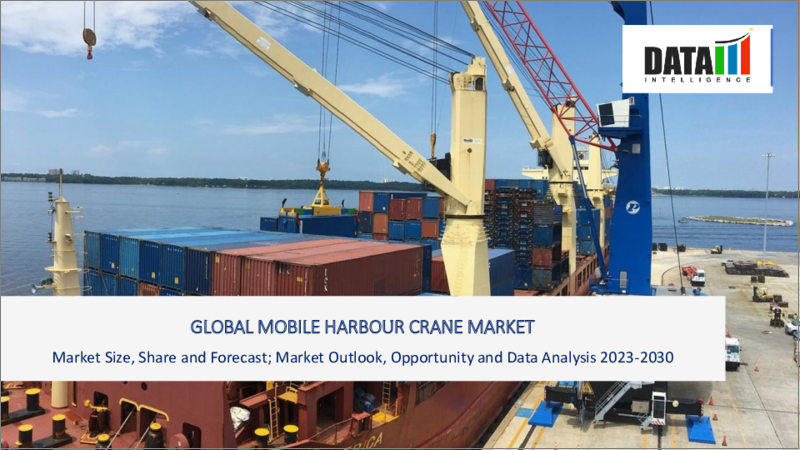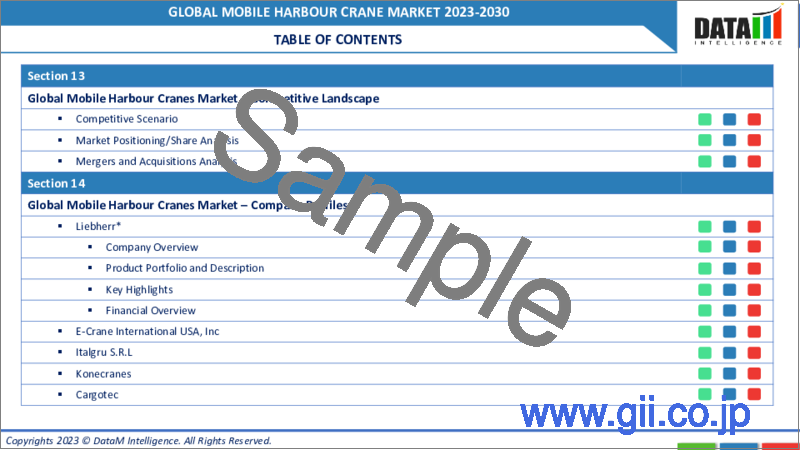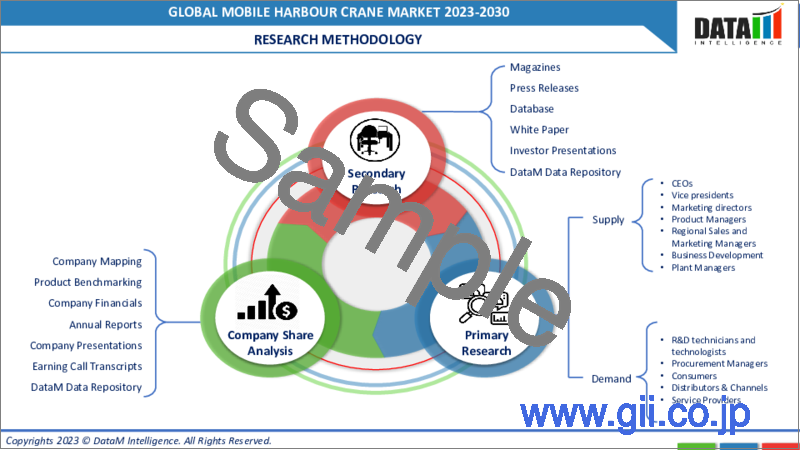|
|
市場調査レポート
商品コード
1176551
移動式港湾クレーンの世界市場-2023-2030Global Mobile Harbor Cranes Market - 2023-2030 |
||||||
|
● お客様のご希望に応じて、既存データの加工や未掲載情報(例:国別セグメント)の追加などの対応が可能です。 詳細はお問い合わせください。 |
|||||||
| 移動式港湾クレーンの世界市場-2023-2030 |
|
出版日: 2022年12月26日
発行: DataM Intelligence
ページ情報: 英文 172 Pages
納期: 約2営業日
|
- 全表示
- 概要
- 目次
市場概要
移動式港湾クレーン市場は、予測期間(2023~2030年)に25.1%のCAGRで大きく成長すると予測されています。
移動式港湾クレーンは、油圧システムで操作し、キャビンから制御することができます。港のクルーズターミナルで重量物と高さのある荷物の両方を扱うため、幅広い用途があります。宇宙、産業、港湾での重量物運搬、建設業など多目的に使用でき、汎用性があります。港湾では、コンテナからバルク商品、一般貨物、重量物まで、さまざまな貨物を取り扱うため、移動式港湾クレーンが採用されています。
世界の移動式港湾クレーンの市場力学
デジタル化の進展や商品貿易に対する意識の高まりにより、世界的に輸出入の需要が高まっています。しかし、原材料価格の変動や、ポートオートメーション、レールマウントガントリクレーン、フローティングクレーンなどの代替手段の利用が、市場の大きな抑制要因になる可能性があります。
デジタル化の進展と商品貿易に対する意識の高まりにより、世界各地で輸出入の需要が増加
人々の商品貿易に対する意識の高まりにより、世界中で商品の国際貿易が増加していることが、移動式港湾クレーン市場を牽引しています。例えば、世界貿易機関(WTO)によると、世界の商品貿易は約19兆4800億米ドルと評価され、17兆3300億米ドルから増加しました。これは、それぞれの港で輸出入品を扱うための移動式港湾クレーンの大規模な需要を作成しました。欧州は商品貿易全体の37%を占め、次いでアジア太平洋地域が約6兆9100億米ドルと評価されました。
さらに上昇する輸出入活動は、モバイルハーバークレーン市場の需要を推進しました。例えば、世界貿易機関に従って、総輸出と輸入は、欧州で約7兆1,100億米ドルと7兆1,500億米ドルの輸入に相当しています。北米の輸出と輸入は、それぞれ約2兆5,600億米ドルと3兆5,600億米ドルと評価されました。そのため、コンテナ、バルクキャリア、一般的なかさばる材料、貨物を取り扱う港湾のクレーンに対する大規模な需要が生まれました。
移動式港湾クレーンは、高い柔軟性と比較的低い運用コストを提供する最も汎用性の高い港湾クレーンから一般貨物、コンテナ、粗いバルク材料を処理するために適しています。移動式港湾クレーンは、全製品範囲にわたって完全なモジュール性と柔軟性を可能にする、ケープサイズのバルクキャリアをアンロードするまでの小さなバージのための最適化された設計で異なるサイズで利用可能です。非常に汎用性が高く、308トンまでの重量物を持ち上げることができ、小型からメガマックス、ケープまですべての船舶サイズに対応する幅広い製品群をカバーしています。したがって、デジタル化の急増と商品貿易に関する意識の高まりと、世界中の輸出入のための需要の増加は、世界のモバイルハーバークレーン市場のための促進要因として機能します。
原材料価格の変動と、港湾自動化、レールマウント式ガントリークレーン、フローティングクレーンなどの代替手段の利用可能性
移動式港湾クレーンは、クレーンの吊り上げ能力やアウトリーチの長さに応じて、1台当たり250万米ドルから800万米ドルの高い資本コストを必要とします。移動式港湾クレーンは、高性能、高信頼性、経済性、機動性を備えた柔軟なソリューションを提供し、あらゆる港湾業務に貢献することができます。クレーンは、幅広い吊り上げ能力とブームの長さがあり、最も複雑な貨物を扱うことができます。しかし、移動式港湾クレーンの製造に必要な鉄鋼やアルミニウムの原材料価格の変動は大きな問題です。
さらに、革新的な高度港湾オートメーションやフローティングクレーンなどの代替手段が利用できることも、移動式港湾クレーン市場の成長を妨げています。いくつかの主要な港は、自動コンテナシフトを導入しており、重い荷物を扱うために追加の移動式港湾クレーンの使用を回避しています。
中国の上海港は、世界初の無人ボックスターミナルを備えた新しい自動コンテナターミナルの試験運用を開始しました。この港の開発プロジェクトは、2億2,300万平方メートルの面積と約2,350メートルの海岸線面積を占めています。この港は、最大のコンテナ船を扱うことができ、年間約400万TEUを処理するためにフル稼働しています。したがって、自動化されたポートシステムは、モバイルハーバークレーン市場の成長を妨げる可能性があります。
さらにレールマウントガントリーと浮動クレーンは、浮動クレーンが深い海水でバルクコンテナの負荷処理を容易にすることができるように、モバイルハーバークレーンと比較していくつかの利点を持っている代替手段です。一方、レール式ガントリークレーンは安価で、床に設置された軌道に乗り、V溝キャスターで直進を続け、かさばる荷物を運ぶことができます。
COVID-19の影響分析
COVID-19の大流行は、多くの国が商品を通じてのウイルスの拡散を止めるために輸出入業務を停止したため、移動式港湾産業に悪影響を及ぼしています。
2020年の世界貿易機関の報告書によると、COVID-19の流行により世界貿易が13%から32%減少しました。移動式港湾クレーンの市場は、それによって大きな支障をきたしました。COVID-19の流行期間中、移動式港湾クレーンのトップメーカーが受けた新規受注はわずかなものでした。さらに、2020年6月には、複数の国が輸出入の許可を出したため、需要が増加しました。
さらに、COVID-19の流行期間中、いくつかのトップメーカーが移動式港湾クレーンの未受注を終了し、少数の新規受注を獲得しました。例えば、2020年7月、ZHDステベドアーズ(ZHD)はオランダの港で使用するために、環境に優しいGottwald Model 6 Mobile Harbor Cranesを2台、DordrechtとMoerdijkで1台、Konecranesに注文しました。促進要因ルク、スチールコイル、ブレイクバルク、コンテナに対応する新しいモービルハバークレーンは、2021年3月末に納品される予定です。2020年6月以降、需要は安定的に推移しており、COVID-19の流行が終わればいずれは上昇すると思われます。
目次
第1章 移動式港湾クレーンの世界市場- 調査手法と調査範囲
- 調査手法
- 調査目的および調査範囲
第2章 移動式港湾クレーンの世界市場-市場の定義と概要
第3章 移動式港湾クレーンの世界市場-エグゼクティブサマリー
- タイプ別市場内訳
- アプリケーション別市場内訳
- 地域別市場内訳
第4章 移動式港湾クレーンの世界市場-市場力学
- 市場影響要因
- 促進要因
- デジタル化の進展と商取引に対する意識の高まり別、世界の輸出入需要の増加
- 抑制要因
- 港湾オートメーション、レールマウントガントリークレーン、フローティングクレーンハンパなどの代替手段の利用可能性
- ビジネスチャンス
- 影響分析
- 促進要因
第5章 移動式港湾クレーンの世界市場-産業分析
- ポーターのファイブフォース分析
- サプライチェーン分析
- 価格設定分析
- 規制分析
第6章 移動式港湾クレーンの世界市場-COVID-19分析
- COVID-19の市場分析
- COVID-19以前の市場シナリオ
- COVID-19の現在の市場シナリオ
- COVID-19後または将来のシナリオ
- COVID-19の中での価格ダイナミクス
- 需要と供給のスペクトル
- パンデミック時の市場に関連する政府の取り組み
- メーカーの戦略的取り組み
- まとめ
第7章 移動式港湾クレーンの世界市場- タイプ別
- ガントリークレーン
- ハーフガントリークレーン
- ダブルカンチレバーガントリークレーン
第8章 移動式港湾クレーンの世界市場-用途別
- コンテナハンドリング
- バルクハンドリング
- 一般貨物
- 重量物運搬
第9章 移動式港湾クレーンの世界市場-地域別
- 北米
- 米国
- カナダ
- メキシコ
- 欧州
- ドイツ
- 英国
- フランス
- イタリア
- ロシア
- その他欧州
- 南米
- ブラジル
- アルゼンチン
- その他の南米地域
- アジア太平洋地域
- 中国
- インド
- 日本
- オーストラリア
- その他アジア太平洋地域
- 中東とアフリカ
第10章 移動式港湾クレーンの世界市場- 競争情勢
- 競合シナリオ
- 市況分析・シェア分析
- M&A(合併・買収)分析
第11章 移動式港湾クレーンの世界市場-企業プロファイル
- Volvo Group
- 企業概要
- 製品ポートフォリオと説明
- 主なハイライト
- 財務概要
- Italgru S.R.L
- Konecranes
- Liebherr
- Mantsinen Group
- GENMA
- SANY
- KOCKS ARDELT KRANBAU
- SENNEBOGEN
第12章 移動式港湾クレーンの世界市場- 重要考察
第13章 移動式港湾クレーンの世界市場-DataM
Market Overview
Mobile Harbour Cranes Market reached US$ XX million in 2022 and is expected to record significant growth by reaching up to US$ XX million by 2030, growing at a CAGR of 25.1% during the forecast period (2023-2030).
Mobile harbor cranes can be operated with hydraulics systems and controlled by the cabin. It has wide applications to handle both the weight and high-height loads at the port's cruise terminals. It has versatile applications in space, industry, at port for heavy load handlings and in the construction industry, making it universal. A mobile harbor crane is employed at the seaport to handle various cargo, ranging from containers to bulk commodities, general cargo and even heavy lifts.
Global Mobile Harbor Cranes Market Dynamics
With the surge in digitalization and increasing awareness about the merchandise trade in the forecast period, the rising demand for import and export across the world. However, fluctuating raw material prices and the availability of alternative methods such as port automation, rail-mounted gantry cranes and the floating crane could be a major market restraint.
Rising demand for import and export across the world with the surge in digitalization and increasing awareness about the merchandise trade
Increasing international trade of goods around the globe due to rising awareness about the merchandise trade among the people drives the mobile harbor cranes market. For instance, as per the World Trade Organization, the global merchandise trade was valued at around US$ 19.48 trillion, which increased from US$ 17.33 trillion. It created a massive demand for the mobile harbor crane for handling the import-export goods at the respective ports. Europe accounted for 37% of the total merchandise trade, followed by Asia-Pacific, valued at around US$ 6.91 trillion.
Further rising import and export activities propelled the mobile harbor cranes market demand. For instance, as per the World Trade Organization, total exports and imports are valued at around US$ 7.11 trillion and imports at US$ 7.15 trillion in Europe. North America's exports and imports were valued at around US$ 2.56 trillion and US$ 3.56 trillion, respectively. Thus it created a massive demand for cranes at ports for handling containers, bulk carriers, general bulky materials, cargo
The mobile harbor cranes are suitable for handling general cargo, containers and coarse bulk materials from the most versatile port cranes, which offer high flexibility and relatively low operating costs. Mobile harbor cranes are available in different sizes with optimized designs for small barges up to unloading cape-size bulk carriers, which enable full modularity and flexibility across the entire product range. It is extremely versatile, can lift heavy weights to 308 tons and covers a wide product range for all vessel sizes from small to mega max and cape. Therefore, rising demand for import and export across the world, with the surge in digitalization and increasing awareness about the merchandise trade, act as drivers for the global mobile harbor cranes market.
Fluctuating raw material prices and availability of alternative methods such as port automation, rail-mounted gantry cranes and floating crane
Mobile harbor cranes require high capital costs ranging from US$ 2.5 Million to US$ 8 Million per unit as per the cranes' lifting capacity and outreach length. Harbor mobile cranes offer flexible solutions with high performance, reliability, economy and mobility, which benefit any port operation. Crane, available in a wide range of lifting capacities and boom lengths, handles the most complex cargo. However, fluctuation in the raw material prices of the steel and aluminum required for manufacturing mobile harbor cranes is a major problem.
Further availability of alternative methods, such as innovative advanced port automation and floating cranes, hampers the growth of the mobile harbor crane market. Several major ports have installed automated container shifting, which avoided using the additional mobile harbor cranes for handling heavy loads.
China's Port of Shanghai has launched trial operations at its new automated container terminal with the world's first unmanned box terminal. The Port development project occupied an area of 2,23 million square meters and a coastline area of around 2,350 meters. The port can handle the biggest containerships and is fully operational to handle around 4 million TEU annually. Thus automated port systems can hamper the growth of the mobile harbor crane market.
Further rail mounted gantry and floating cranes are the alternative to the mobile harbor crane, which has several benefits compared to mobile harbor cranes, as the floating crane can facilitate load handling of the bulk containers in deep seawater. In contrast, rail gantry cranes are less expensive and can ride along a track installed on the floor and a V-groove caster to keep moving in a straight line for carrying bulky loads.
COVID-19 Impact Analysis
The COVID-19 pandemic negatively influences the mobile harbor industry since numerous nations have halted import and export operations to stop the spread of the virus through commodities.
According to a World Trade Organization report from 2020, the COVID-19 epidemic has reduced global trade by 13% to 32%. The market for mobile harbor cranes has been severely hampered by it. During the COVID-19 pandemic, a top mobile harbor crane manufacturer received a small number of new orders. Additionally, demand rose in June 2020 due to several nations granting permission for import and export.
Furthermore, during the COVID-19 epidemic, several top manufacturers finished outstanding orders and got a small number of new ones for mobile harbor cranes. For instance, in July 2020, ZHD Stevedores (ZHD) ordered two eco-friendly Gottwald Model 6 Mobile Harbor Cranes from Konecranes for use in the ports of the Netherlands, one for Dordrecht and one for Moerdijk. The new mobile harbor crane, which can handle dry bulk, steel coils, breakbulk and containers, will be delivered at the end of March 2021. After June 2020, demand remained stable and will eventually rise once the COVID-19 epidemic is over.
Segment Analysis
The global cellulose ethers market is classified based on type, application and region.
The surge in international trade allows the container handling segment to dominate the application segment of the global mobile harbor crane market
The container handling applications have the highest share of the growth of the mobile harbor crane market; this is primarily due to rising container traffic due to a surge in the international trade at ports which created a colossal demand for this segmental growth. As containers handling is generally done with the help of mobile harbor cranes at the import and export ports, cranes help to load and unload containers from the vessels or ships at ports
Further, several leading players are launching mobile harbor cranes for shifting containers at ports. For instance, on August 27, 2020, the COSCO container shipping line introduced a new container handling crane in a sole million ceremony to facilitate the most modern container handling logistics system in the Baltics and opened at the Baltic port company Container Terminal (BCT). Further, on May 14, 2020, Termont ordered two Liebherr container rubber-tired gantry (RTG) cranes.
Geographical Analysis
Extensive growth in import-export boost the demand and sales of mobile harbor cranes in the Asia-Pacific
Asia-Pacific has the swiftest growth pace in the global mobile harbor crane market. In Asia-Pacific, mobile harbor cranes are majorly used for handling heavy containers of manufactured and agricultural goods. As these goods' international import and export activities increased in this region, it created a massive demand for the mobile harbor crane market. For instance, total export from fuels and mining products, manufactured goods and agriculture grew by 23%, 8% and 5%, respectively, in the developing countries of Asia-Pacific as per the report of the world trade organization
Further increasing import and export of bulk commodities in developing countries such as China and India have propelled the demand for the mobile harbor crane market. For instance, as per the World Trade Organization, China imported around 1.4 billion tons of bulk loads, accounting for around 43.5% of global maritime major bulk trade. According to the same data, ports in developing economies in the Asia-Pacific region have handled 485 million TEUs of containers, accounting for 61 percent of world port container traffic. Thus to handle such heavy container loads, mobile harbor crane plays a vital role in loading and unloading the containers from vessels to ports
Also, as per UNCTAD maritime report, Asia-Pacific is the largest trading region accounting for around 4.5 billion tons of goods loading and 6.7 billion tonnes of goods unloading, which created a huge demand for the mobile harbor crane for loading and unloading goods at Asia-Pacific's seaports.
Global Mobile Harbor Cranes Market Competitive Landscape
The global cellulose ethers market is huge and is becoming increasingly competitive due to the presence of major players such as Italgru S.R.L, Konecranes, Liebherr, Mantsinen Group, GENMA, SANY, KOCKS ARDELT KRANBAU, SENNEBOGEN and Volvo Group. The market is fragmented and market players employ market tactics such as mergers, acquisitions, product launches, contributions and collaborations to gain a competitive advantage and recognition.
Kocks Ardelt Kranbau
Overview: Kocks Ardelt Kranbau is a double jib level luffing cranes manufacturer. The company has acquired around 132 patents for double jib level luffing systems. The company offers general cargo handling, dry bulk handling, container handling and ship-building services. The company provides a portfolio of the cranes such as double-jib level luffing cranes, jib cranes, balancer cranes, Tukan M & S, Tukan K & B, Tukan F, Kondor, Kranich and Pelikan
Product Portfolio:
SAC1600S: The product is a 160 tons all-terrain crane with 160t maximum Lifting capacity and 73m maximum boom length. It has a maximum lifting height of 101m and a maximum lifting capacity of 40t.
Key Development:
On August 27, 2020, the Kocks Ardelt Kranbau delivered TUKAN 3000 to Brunsbuttel Port with a third double jib level luffing crane with a maximum lifting capacity of 120t, a radius of 63m and an overall height of 75m.
Why Purchase the Report?
- To visualize the global cellulose ethers market segmentation based on type, application and region, as well as understand key commercial assets and players.
- Identify commercial opportunities in the global cellulose ethers market by analyzing trends and co-development.
- Excel data sheet with numerous cellulose ethers market-level data points with four segments.
- PDF report consisting of cogently put together market analysis after exhaustive qualitative interviews and in-depth market study.
- Product mapping available as excel consisting of key products of all the major market players
The global cellulose ethers market report would provide approximately 50 tables, 47 figures and almost 172 pages.
Product Audience 2023
- Manufacturers/ Buyers
- Industry Investors/Investment Bankers
- Research Professionals
- Emerging Companies
Table of Contents
1. Global Mobile Harbor Cranes Market - Methodology and Scope
- 1.1. Research Methodology
- 1.2. Research Objective and Scope of the Report
2. Global Mobile Harbor Cranes Market - Market Definition and Overview
3. Global Mobile Harbor Cranes Market - Executive Summary
- 3.1. Market Snippet by Type
- 3.2. Market Snippet by Application
- 3.3. Market Snippet by Region
4. Global Mobile Harbor Cranes Market-Market Dynamics
- 4.1. Market Impacting Factors
- 4.1.1. Drivers
- 4.1.1.1. Rising demand for import and export across the world with the surge in digitalization and increasing awareness among the people about the merchandise trade
- 4.1.1.2. XX
- 4.1.2. Restraints
- 4.1.2.1. Availability of alternative methods such as port automation, rail-mounted gantry cranes and floating crane hampers
- 4.1.2.2. XX
- 4.1.3. Opportunity
- 4.1.3.1. XX
- 4.1.4. Impact Analysis
- 4.1.1. Drivers
5. Global Mobile Harbor Cranes Market - Industry Analysis
- 5.1. Porter's Five Forces Analysis
- 5.2. Supply Chain Analysis
- 5.3. Pricing Analysis
- 5.4. Regulatory Analysis
6. Global Mobile Harbor Cranes Market - COVID-19 Analysis
- 6.1. Analysis of COVID-19 on the Market
- 6.1.1. Before COVID-19 Market Scenario
- 6.1.2. Present COVID-19 Market Scenario
- 6.1.3. After COVID-19 or Future Scenario
- 6.2. Pricing Dynamics Amid COVID-19
- 6.3. Demand-Supply Spectrum
- 6.4. Government Initiatives Related to the Market During the Pandemic
- 6.5. Manufacturers Strategic Initiatives
- 6.6. Conclusion
7. Global Mobile Harbor Cranes Market - By Type
- 7.1. Introduction
- 7.1.1. Market Size Analysis and Y-o-Y Growth Analysis (%), By Type
- 7.1.2. Market Attractiveness Index, By Type
- 7.2. Gantry Crane*
- 7.2.1. Introduction
- 7.2.2. Market Size Analysis and Y-o-Y Growth Analysis (%)
- 7.3. Half Gantry Crane
- 7.4. Double Cantilever Gantry Crane
8. Global Mobile Harbor Cranes Market - By Application
- 8.1. Introduction
- 8.1.1. Market Size Analysis and Y-o-Y Growth Analysis (%), By Application
- 8.1.2. Market Attractiveness Index, By Application
- 8.2. Container Handling*
- 8.2.1. Introduction
- 8.2.2. Market Size Analysis and Y-o-Y Growth Analysis (%)
- 8.3. Bulk Handling
- 8.4. General Cargo
- 8.5. Heavy Lift
9. Global Mobile Harbor Cranes Market - By Region
- 9.1. Introduction
- 9.1.1. Market Size Analysis and Y-o-Y Growth Analysis (%), By Region
- 9.1.2. Market Attractiveness Index, By Region
- 9.2. North America
- 9.2.1. Introduction
- 9.2.2. Key Region-Specific Dynamics
- 9.2.3. Market Size Analysis and Y-o-Y Growth Analysis (%), By Type
- 9.2.4. Market Size Analysis and Y-o-Y Growth Analysis (%), By Application
- 9.2.5. Market Size Analysis and Y-o-Y Growth Analysis (%), By Country
- 9.2.5.1. U.S.
- 9.2.5.2. Canada
- 9.2.5.3. Mexico
- 9.3. Europe
- 9.3.1. Introduction
- 9.3.2. Key Region-Specific Dynamics
- 9.3.3. Market Size Analysis and Y-o-Y Growth Analysis (%), By Type
- 9.3.4. Market Size Analysis and Y-o-Y Growth Analysis (%), By Application
- 9.3.5. Market Size Analysis and Y-o-Y Growth Analysis (%), By Country
- 9.3.5.1. Germany
- 9.3.5.2. UK
- 9.3.5.3. France
- 9.3.5.4. Italy
- 9.3.5.5. Russia
- 9.3.5.6. Rest of Europe
- 9.4. South America
- 9.4.1. Introduction
- 9.4.2. Key Region-Specific Dynamics
- 9.4.3. Market Size Analysis and Y-o-Y Growth Analysis (%), By Type
- 9.4.4. Market Size Analysis and Y-o-Y Growth Analysis (%), By Application
- 9.4.5. Market Size Analysis and Y-o-Y Growth Analysis (%), By Country
- 9.4.5.1. Brazil
- 9.4.5.2. Argentina
- 9.4.5.3. Rest of South America
- 9.5. Asia-Pacific
- 9.5.1. Introduction
- 9.5.2. Key Region-Specific Dynamics
- 9.5.3. Market Size Analysis and Y-o-Y Growth Analysis (%), By Type
- 9.5.4. Market Size Analysis and Y-o-Y Growth Analysis (%), By Application
- 9.5.5. Market Size Analysis and Y-o-Y Growth Analysis (%), By Country
- 9.5.5.1. China
- 9.5.5.2. India
- 9.5.5.3. Japan
- 9.5.5.4. Australia
- 9.5.5.5. Rest of Asia-Pacific
- 9.6. Middle East and Africa
- 9.6.1. Introduction
- 9.6.2. Key Region-Specific Dynamics
- 9.6.3. Market Size Analysis and Y-o-Y Growth Analysis (%), By Type
- 9.6.4. Market Size Analysis and Y-o-Y Growth Analysis (%), By Application
10. Global Mobile Harbor Cranes Market - Competitive Landscape
- 10.1. Competitive Scenario
- 10.2. Market Positioning/Share Analysis
- 10.3. Mergers and Acquisitions Analysis
11. Global Mobile Harbor Cranes Market- Company Profiles
- 11.1. Volvo Group*
- 11.1.1. Company Overview
- 11.1.2. Product Portfolio and Description
- 11.1.3. Key Highlights
- 11.1.4. Financial Overview
- 11.2. Italgru S.R.L
- 11.3. Konecranes
- 11.4. Liebherr
- 11.5. Mantsinen Group
- 11.6. GENMA
- 11.7. SANY
- 11.8. KOCKS ARDELT KRANBAU
- 11.9. SENNEBOGEN
LIST NOT EXHAUSTIVE
12. Global Mobile Harbor Cranes Market - Premium Insights
13. Global Mobile Harbor Cranes Market - DataM
- 13.1. Appendix
- 13.2. About Us and Services
- 13.3. Contact Us




